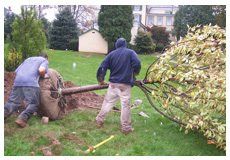

TREE SELECTION
Tree selection is one of the most important investment decisions a home owner makes when landscaping a new home or replacing a tree lost to damage or disease. Considering that most trees have the potential to outlive the people who plant them, the impact of this decision is one that can influence a lifetime. Match the tree to the site, and both lives will benefit.
The question most frequently asked of tree care professionals is “Which kind of tree do you think I should plant?” Before this question can be answered, a number of factors need to be considered. Think about the following questions:
- Why is the tree being planted? Do you want the tree to provide shade, fruit, or seasonal color, or act as a windbreak or screen? Maybe more than one reason?
- What is the size and location of the planting site? Does the space lend itself to a large, medium, or small tree? Are there overhead or belowground wires or utilities in the vicinity? Do you need to consider clearance for sidewalks, patios, or driveways? Are there other trees in the area? Are there barriers to future root growth, such as building foundations?
- Which type of soil conditions exist? Is the soil deep, fertile, and well drained, or is it shallow, compacted, and infertile?
- Which type of maintenance are you willing to provide? Do you have time to water, fertilize, and prune the newly planted tree until it is established, or will you be relying on your garden or tree service for assistance?
Asking and answering these and other questions before selecting a tree will help you choose the “right tree for the right place.”

TREE FUNCTION
Trees make our surroundings more pleasant. Properly placed and cared for, trees increase the value of our real estate. A large shade tree provides relief from summer’s heat and, when properly placed, can reduce summer cooling costs. An ornamental tree provides beautiful flowers, leaves, bark, or fruit. Evergreens with dense, persistent leaves can be used to provide a windbreak or a screen for privacy. A tree that drops its leaves in the fall allows the sun to warm a house in the winter. A tree or shrub that produces fruit can provide food for the owner and/or attract birds and wildlife into your home landscape. Street trees decrease the glare from pavement, reduce runoff, filter out pollutants, and add oxygen to the air we breath. Street trees also improve the overall appearance and quality of life in a city or neighborhood.
SPECIES SELECTION
Personal preferences play a major role in the selection process. Now that your homework is done, you are ready to select a species for the planting site you have chosen. Make sure you use the information you have gathered about your site conditions, and balance it with the aesthetic decisions you make related to your personal preferences.
The species must be suitable for the geographic region (hardy), tolerant to the moisture and drainage conditions of your soil, be resistant to pests in your area, and have the right form and size for the site and function you have envisioned.
Remember, the beautiful picture of a tree you looked at in a magazine or book was taken of a specimen that is growing vigorously because it was planted in the right place. If your site conditions tell you the species you selected will not do well under those conditions, do not be disappointed when the tree does not perform in the same way.
If you are having difficulty answering any of these questions on your own, contact a local ISA Certified Arborist, tree care professional, garden center, or extension agent for assistance. Their assistance will help you to plant the “right tree in the right place.” It is better to get a professional involved early and help you make the right decision than to call him or her later to ask if you made the wrong decision.
